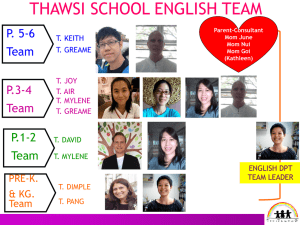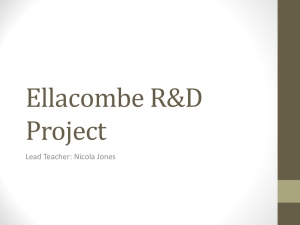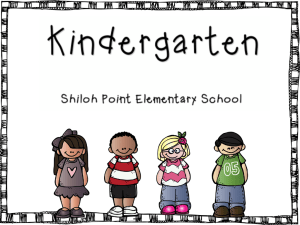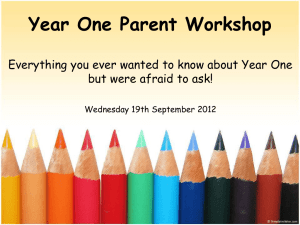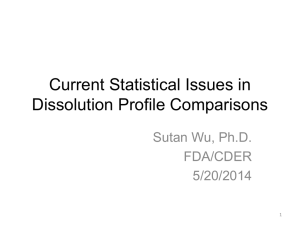What Knowledge Do Learners Need Before Starting
advertisement
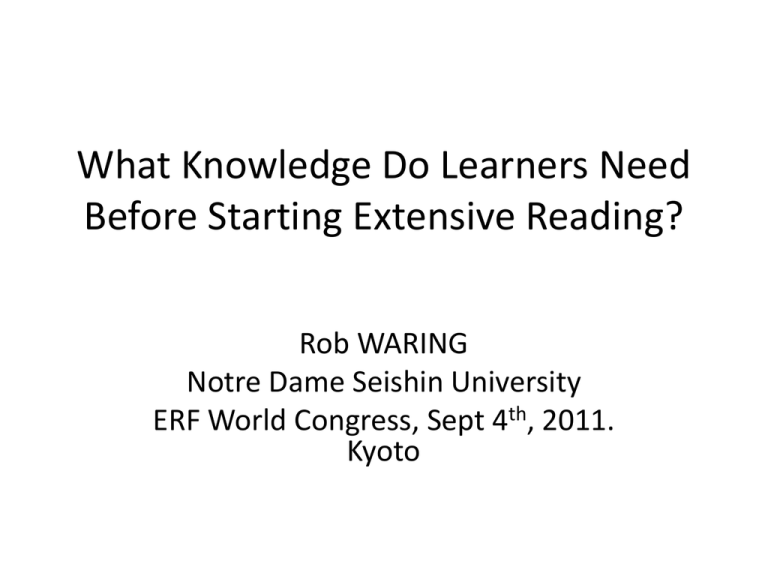
What Knowledge Do Learners Need Before Starting Extensive Reading? Rob WARING Notre Dame Seishin University ERF World Congress, Sept 4th, 2011. Kyoto Assumptions There is a threshold of knowledge needed before students can read extensively: linguistic – very basic words, grammar etc. alphabetic understanding of book and text structure understanding of how text flows We could call this ‘bootstrapping’ knowledge In addition, learners need to understand why they need to read extensively Definition of ER ER involves reading with a primary focus on the message to practice the skill of reading The following are preferred but not essential faster is better than not reading more is better reading enjoyably is better Occasional reading speed bumps are to be expected No clear line between IR and ER INTENSIVE READING EXTENSIVE READING Language development MAIN FOCUS Content, message, story Careful READING Holistic Slower SPEED Faster Dense with unknown words Awareness raising TEXT DENSITY Few unknown words SKILLS Practice of the skills This implies … Initially, the reading can only be intensive to some degree until the automatic recognition of given words and phrases is reached. Before starting to read, students need some level of awareness of: -form-meaning relationships (/æpl/ is rendered apple ) -how letters represent sounds (phonics) Automatic recognition of a given word will be hampered by unknown co-text – slowing the building of automaticity Therefore, it’s essential that initial reading material is highly controlled to build automatic sight recognition of the core ‘kick-start’ vocabulary quickly Bootstrapping Learning the code (probably individually and discrete) learning a kickstart oral vocabulary learning how letters refer to sounds decoding how letter combinations work etc. Combining phase combining the discrete items into larger units contextualizing items Automatizing phase – e.g. controlled practice automatizing that knowledge so it becomes less conscious automatizing from the small to the large Then on to Extensive Reading Sequential or concurrent bootstrapping? One approach is to do all this concurrently -learning the code, combining, automatizing in one class and ER in another at or about the same time -this is good for consolidation and making connections -does it overload learners? Another is to deal with each separately initially (possibly sequentially) and bring in ER later -easier to manage / teach -less load on the students -possible forgetting if little reinforcement and few connections are made Furukawa (2008) A concurrent approach from 7th grade in cram school 80 minutes normal class; 80 minutes ER for 48 weeks 30,000 books to choose from, 2000 CDs, 100DVDs By 9th grade they had read 670,000 words and outperformed students 2 years older also attending cram school on the reading and listening aspects of the ACE test after controlling for the same time in classes ER made the difference Bootstrapping what knowledge and skills? Minimum linguistic knowledge words, phrases grammatical alphabetical / phonetic knowledge of how sounds match meanings and written words Textual Text shape: sentences, paragraphs, speech Direction: left to right text, left to right page order etc. Text type: story book vs alphabet book vs text book Book structure: Cover, body, etc. Bootstrapping what knowledge and skills? 2 Story / Plot Structure Beginning, Middle, End Told in time order Plausible events Sense of narrative etc. Metalanguage of reading (probably in L1) reading speed, automaticity, repeated reading, parts of speech (noun, verb, adjective), basic grammatical terms (subject, object) etc. etc. Learning the code: Don’t start with the alphabet Words follow the alphabetic principle that letters are used to represent speech sounds (phonemes) We don’t use the alphabet for reading – reading is sound basedi.e. – phonic: /kæt/ not C-A-T /ai/ not E-Y-E The alphabet is used for spelling (for writing) not pronouncing / reading Writing is usually the last skill to be learnt in EFL So introduce the alphabet later when they start to write No need to confuse them with two systems for sounds and letters early on Bootstrapping the sound-letter code Systematic Phonics (hat + e = hate ; b oo k = book) Focus on underlying patterns for dealing with unmet words But: Often very mechanical, and repetitive Lots of memorization and behavioristic learning Tries to protect children from mistakes Temptation to keep on teaching phonic elements when the kids want to / are ready to read Can lead to boredom Active Phonics Uses game play, movement and activity and makes children think more than traditional systematic phonics Children should sound out words Order of presentation: Vowels, consonants, Vowel consonant combinations, longer words with basic vowels etc. Start with regularly spelled words, irregulars later Problems with phonics It probably involves some one-to-one teaching / monitoring Students / parents may not understand the reason the students are ‘delaying’ reading Bootstrapping the vocabulary EFL Children don’t have the huge benefit of oral vocabulary L1 Children do. Students probably need an oral vocabulary of about 200 words before picking up their first book to read it These can be learnt contextually by listening to stories being told with very easy picture books e.g. Oxford Reading Tree Or de-contextually through flashcards and games etc. A bootstrap vocabulary Function words about at for from into of with to he I it she some they we what where you there this down in on and but a/an the not out why really very ok Content words angry big every good happy sorry goodbye here yes no please now be do have ask come get give go know listen look play say see show take tell thank think want watch run start talk wait walk day friend man name A bootstrap vocabulary 2 Some of these words are probably known orally or as loanwords by 10 year-olds a.m. address afternoon air America apple April arm august bag ball banana bank baseball bath bathroom beach bed beef bicycle bike bird black blue boat body book boy boyfriend bread breakfast brother brown bus cake car cat cheese chicken chocolate class classroom clock coffee cola computer cup dad dance December dictionary dinner doctor dog door dress ear eight eleven English eye face father February first fish five floor flower food football fork four Friday fruit game girl girlfriend glass golf green hair hall hamburger hand hat head home homework hotel hour house hundred ice inch internet January jeans juice July June key kilo kilometer knife lamp leg lemon madam march meal meat menu mile milk minute miss Monday money month moon morning mother motorbike mouth movie Mr. Mrs. music newspaper night nine November October office orange paper park pasta pen pencil phone pizza rain red restaurant rice river salad sandwich Saturday school sea second September seven ship shirt shoe shopping sir sister six skirt snow soccer sport station steak store student study sun Sunday table taxi tea television ten tennis thousand three Thursday today tomato tomorrow train tree Tuesday two water Wednesday white word world yellow yesterday Building automaticity / sight vocabulary Recognition games (find the odd one out) Discrimination games (find cat in a jumble of words) Once they’ve read a text once: Repeated readings Reading 10% faster Timed readings Race your partner (all with comprehension) Bootstrapping Grammar Grammar isn’t the basis of language – meaning is The grammar of a sentence often emerges from the properties of the main verb and its meaning (human subject) give (something one can give) to (someone) She gave a birthday present to her boyfriend *Happiness gave a walk to a fish (human subject) give (someone) She gave her boyfriend *Happiness gave the fish (something one can give) a birthday present a walk Bootstrapping Grammar 2 There are a very few grammatical patterns that need teaching explicitly: - word order - tenses - relative clauses Most of the rest is basically lexical or grammaticalized lexis (and messy!) -If patterns, not only but also, etc. -prepositions -comparatives and superlatives, as ____ as -for, since, during, while -conjunctions etc. A lot of grammar is late acquired, so why focus on it so early? (e.g. articles) Grammar awareness comes after massive exposure so at the bootstrapping stage, it’s best to avoid discussion of grammar except possibly basic word order. The above suggests To bootstrap initial knowledge there should be some focus on: intentional learning – e.g. word games, phonics games incidental learning – assisted graded reading; reading along, buddy reading Later intentional reinforcement can be added – early unassisted graded reading, repeated readings, fluency work It should be fun, not serious work. Then they can move on to early teacher-selected and selfselected unassisted reading Which materials to start unassisted reading with? Many teachers say they can’t do ER because their students aren’t ready linguistically – thus they need this threshold knowledge Most EFL Graded Readers are said to be too difficult for absolute beginners – even the level 1 books Foundations Reading Library (from 75 headwords) Building Blocks Reading Library (from 170 headwords) Penguin Readers / Bookworms, etc. (from 200/250 headwords) It’s likely beginners can only read these intensively (i.e. main focus on language forms not meaning) Many reading series jump through the levels too quickly so we can expect some regress in speed as learners move up levels This implies learners should not stick with one graded reader scheme so they can smoothen out the gaps between levels. The problem with Child L1 texts Child L1 material: assumes an oral vocab of several hundred words isn’t scaffolded as carefully as graded reader materials – thus learners may meet many rare words isn’t graded to match normal EFL courses and syllabuses is not always age appropriate Phonics readers These carefully control the spellings / sight/sound combinations students read But often have unnatural and contrived language as there is a lot of alliteration (Sue sang seven songs) They are more like practice books than graded readers The first reading experience: Knowledge-based approaches Whole-word reading (memorizing book, dog, father as whole words) focuses on complete words not underlying patterns Whole language reading (e.g. teacher reads to a class) learn by reading and working it out as you go, little analysis requires a lot of oral exposure to see patterns Reading aloud Based on memorizing whole words Often kids do not internalize the meanings / patterns, only parrot them It doesn’t prepare them well to deal with unfamiliar words Can lead to passive students What to do? Most Asian EFL languages are not orthographically transparent (one sound = one letter as in Spanish or Finnish) so some help in decoding the system can be helpful initially Some children may not need phonic instruction as they can move to whole-language reading smoothly. Others will need some help. If in doubt – teach phonics – it will help even those who don’t really need it, but greatly help those who do Teaching phonics helps writing and spelling Move on to whole-language reading as soon as possible Learning lists is a fast way to learn words. It is decontextual (whole word learning) and needs contextualizing as soon as possible Affective considerations Learners need to be emotionally engaged / drawn in by the texts or presentation so : they can notice things e.g. words they will be stimulated to want more they can follow the story more easily They need to feel success and achievement The text / reading presentation should challenge them to think not just let the story wash over them It’s not always necessary to be too clear when presenting, as it leaves a space into which the children can think. Clarity comes at the end. They need to link the new to the old so it can be internalized Younger learners need to be free to learn the way they want and not forced into categories of ‘good’ ‘bad’ ‘fast’ ‘slow’ etc. We should encourage them to not worry about mistakes The best approach for building bootstrapping knowledge? There isn’t one …. The appropriate balance and sequence of learning / teaching the code, building an initial oral vocabulary and so on depends on: the students the class size the learning styles resources teaching styles time available the curriculum etc. Thank you for your time Contact Rob Waring waring_robert@yahoo.com www.robwaring.org What minimum Teacher knowledge / resources are necessary? Knowledge of what ER is and its aims Ability to read and pronounce English well Appropriately leveled books / reading materials
